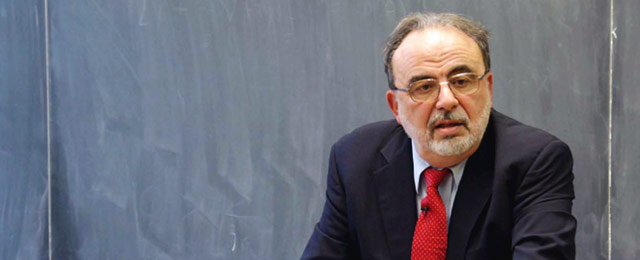Online courses directory (186)
A chronological and thematic survey of the major themes and developments in the history of Latin American art, this course traces the evolution of visual culture over approximately four millennia. Organized into three parts, the course begins with the pre-Columbian period (1800 BC to AD 1492), moves into the years of European contact and conquest (AD 1492 to 1800), and concludes with an overview of modern and contemporary art across the Americas. You will learn to identify and describe works of art and discuss the broader historical and social contexts in which they were produced and circulated. The first part of the course will introduce you to the major artistic achievements and archaeological record of the ancient Mesoamerican and Andean cultures: monumental architecture, urban planning, painting, sculpture, and portable arts. The study of colonial art focuses on Mexico, Peru, and Brazil, introducing concepts of artistic hybridity and diversity, indigenous and national cultures, and transatlantic e…
In this course, we will study the history of Eastern (Orthodox) Christian art. The course begins with an overview of the emergence of Christianity in the Late Antique period and the formation of the Christian visual language that grew out of the Classical tradition. The course then follows the development of Christian art after the fall of the Roman Empire and the emergence of a “new Rome” in the East: the Byzantine Empire. A series of reading assignments paired with lectures and virtual tours will introduce you to important works of Early Christian and Byzantine art and will also give you an understanding of the central debates of Early Christian and Byzantine art historical scholarship. By the time you finish the course, you will be able to identify the most important artworks from this period and understand how their appearances relate to the social, political, and religious environment in which they were produced. You will also be able to trace the ways in which Early Christian and Byzantine…
This course serves as an introduction to the Buddhist artistic traditions of South, Southeast, and East Asia, as well as the Himalayas. It is organized into four units based on the development of Buddhist schools and artistic traditions in Southeast Asia, the Himalayas, and China, Korea, and Japan. The first unit surveys the core tenets of Buddhism, Buddhist iconography, and early Buddhist art and architecture in India. The second unit reviews the development of Buddhist art and architecture in Southeast Asia, focusing on the patronage of Theravada and Mahayana Buddhism by rulers in the modern countries of Indonesia, Cambodia, Myanmar, and Thailand. Unit three examines the particular form of Vajrayana Buddhism and its artistic traditions that developed in the Himalayas. The final unit traces the spread of Mahayana Buddhist art and architecture into China and later into Korea and Japan via the Silk Roads. All four units highlight the interaction between Buddhist doctrine, art, and architecture; Bud…
In common conversation, we often use the phrase “contemporary art” to refer to current artistic productionthe art being produced today. However, in the art history field, the phrase denotes a specific period of art and artistic practice starting in the 1960s and continuing today. It is characterized by a break from the modernist artistic canon and a desire to move away from the dominant Western cultural model, looking for inspiration in everyday and popular culture. More specifically, many contemporary artworks reject traditional modernistic artistic media (such as painting or sculpture) in favor of a more collaborative, ephemeral, and multimedia approach that further blurs the boundaries between high and mass culture. In its subject matter, this art also tends to reflect a shift away from purely aesthetic issues to more socially oriented concerns. Finally, it is important to note that contemporary art should not be seen as a progression of different artistic styles but as series of different cu…
In this course, we will study the architecture of Ancient Rome, beginning with its origins in the eighth century BC, and continuing through the fourth century AD with the move of the Roman capital to Constantinople. The course of lectures and readings outlined below will familiarize you with the major building methods and styles used in Roman architecture. In addition, interior decoration (including the very important topic of Roman wall painting) will be addressed. By the end of the course, you will be able to identify some of the most important works of Roman architecture and discuss the historical and cultural conditions that informed their production. An important theme throughout the first half of the course is the relationship between Ancient Rome and Greek and Etruscan cultures, which were highly influential in the formation of a distinctive Roman architecture. Understanding the role that Roman architecture played in the eastern and western Roman provinces is also significant to this course,…
Arts and culture leaders have a rewarding but tough task: creating sustainable organizations that deliver real social value. There is a lot of competition out there. Being an effective leader means constantly adapting, cleverly using the best tools to reach as many people as possible. This course is designed to help leaders at any level do just that.
In this course you will learn about audio signal processing methodologies that are specific for music and of use in real applications. You will learn to analyse, synthesize and transform sounds using the Python programming language.
This course provides students with a basic knowledge of structural analysis and design for buildings, bridges and other structures. The course emphasizes the historical development of structural form and the evolution of structural design knowledge, from Gothic cathedrals to long span suspension bridges. Students will investigate the behavior of structural systems and elements through design exercises, case studies, and load testing of models. Students will design structures using timber, masonry, steel, and concrete and will gain an appreciation of the importance of structural design today, with an emphasis on environmental impact of large scale construction.
This class offers a foundation in the visual art practice and its critical analysis for beginning architecture students. Emphasis is on long-range artistic development and its analogies to architectural thinking and practice. Students will learn to communicate ideas and experiences through various two-dimensional, and three-dimensional, and time-based media, including installations, performance and video. Lectures, visiting artist presentations, field trips, and readings supplement studio practice.
This course offers an introduction to the history, theory, and construction of basic structural systems as well as an introduction to energy issues in buildings. It emphasizes basic systematic and elemental behavior, principles of structural behavior, and analysis of individual structural elements and strategies for load carrying. The course also introduces fundamental energy topics including thermodynamics, psychrometrics, and comfort. It is a required class for M. Arch. students.
This course addresses advanced structures, exterior envelopes and contemporary production technologies. It continues the exploration of structural elements and systems, and expands to include more complex determinate, indeterminate, long-span and high-rise systems. It covers topics such as reinforced concrete, steel and engineered wood design, and provides an introduction to tensile systems. Lectures also address the contemporary exterior envelope with an emphasis on their performance attributes and advanced manufacturing technologies. This course is required of MArch students.
In this class, concepts of building technology and experimental methods are studied, in class and in lab assignments. Projects vary yearly and have included design and testing of strategies for daylighting, passive heating and cooling, and improved indoor air quality via natural ventilation. Experimental methods focus on measurement and analysis of thermally driven and wind-driven airflows, lighting intensity and glare, and heat flow and thermal storage. Experiments are conducted at model and full scale and are often motivated by ongoing field work in developing countries.
This course serves as an introduction to urban form and design, focusing on the physical, historical, and social form of cities. Selected cities are analyzed, drawn, and compared, to develop a working understanding of urban and architectural form. The development of map making and urban representation is discussed, and use of the computer is required. A special focus is placed on the historical development of the selected cities, especially mid-nineteenth and mid-twentieth century periods of expansion. Readings focus on urban design theory in the twentieth century and will be discussed during a weekly seminar on them. This is a methods class for S.M.Arch.S. students in Architecture and Urbanism.
The course facilitates a close reading of Don Quixote in the artistic and historical context of renaissance and baroque Spain. Students are also expected to read four of Cervantes' Exemplary Stories, Cervantes' Don Quixote: A Casebook, and J.H. Elliott's Imperial Spain. Cervantes' work will be discussed in relation to paintings by Velázquez. The question of why Don Quixote is read today will be addressed throughout the course. Students are expected to know the book, the background readings and the materials covered in the lectures and class discussions.
Do you want to think about ways to help solve New Orleans' problems? CityScope is a project-based introduction to the contemporary city. "Problem solving in complex (urban) environments" is different than "solving complex problems." As a member of a team, you will learn to assess scenarios for the purpose of formulating social, economic and design strategies to provide humane and sustainable solutions. A visit to New Orleans is planned for spring break 2007.
Graphic designers, artists, photographers and all those involved in the visual arts need an accurate understanding of colour theory. This free online course from ALISON presents aspects of colour and light perception such as hue, lightness and chroma, brightness and saturation, visual perception of colour, mixing paints, and additive and subtractive colour mixing. The comprehensive text is accompanied by interactive graphics that further explain the concepts. This course is ideal for any learner who practices the visual arts, either professionally or as a hobby, and who wants to greatly enhance their knowledge and understanding of colour theory.
Comic books have arrived! "Comic Books and Graphic Novels" presents a survey of the Anglo-American comic book canon and of the major graphic novels in circulation in the United States today. Its governing question is simple: by what terms can we discuss comic books as literary art? In pursuit of that question it develops a theory of literary reading and time itself. Visit us at www.facebook.com/UCBComics or bit.ly/project10-4 to see some student-created comics from 2013!
This class explores composition and arrangement for the large jazz ensemble from 1920s foundations to current postmodern practice. Consideration given to a variety of styles and to the interaction of improvisation and composition. Study of works by Basie, Ellington, Evans, Gillespie, Golson, Mingus, Morris, Nelson, Williams, and others. Open rehearsals, workshops, and performances of student compositions by the MIT Festival Jazz Ensemble and the Aardvark Jazz Orchestra.

















